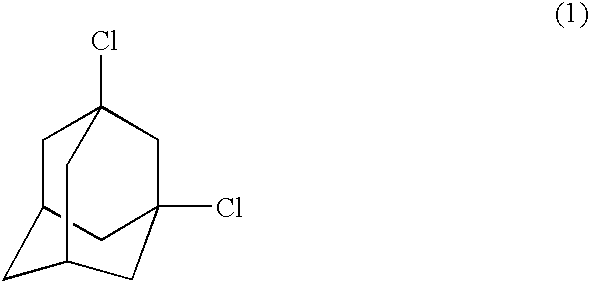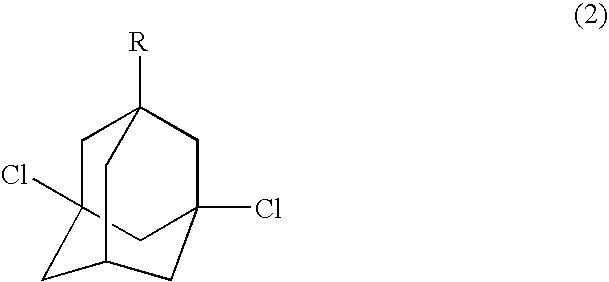Process for preparing dihalogenated adamantanes
a technology of dihalogenated adamantane and process, which is applied in the field of process for preparing dihalogenated adamantane, can solve the problems of low yield of dihalogenated adamantane, trihalogenated derivatives, and excessive proceeding, and achieve high yield
- Summary
- Abstract
- Description
- Claims
- Application Information
AI Technical Summary
Benefits of technology
Problems solved by technology
Method used
Image
Examples
example 1
In a 100 mL three-necked flask was placed 5.0 g of adamantane (0.037 mol) and then the inside of the flask was dried by purging with nitrogen gas. Under the nitrogen stream, the flask was cooled to an internal temperature of 0° C., and then 43.1 g of chlorosulfonic acid (0.37 mol) was added dropwise. The reaction mixture as a suspension was warmed to 10° C. to initiate the first stage reaction with effervescence. The reaction was maintained at the temperature until effervescence ceased. After 2 hours, the reaction became a clear and homogeneous solution.
The reaction mixture was warmed to 20° C. to initiate the second stage reaction with mild effervescence again. The reaction was maintained under the conditions for 5 hours. The reaction mixture as a suspension was filtrated under a nitrogen atmosphere. The solid thus obtained was poured into ice-water and extracted with chloroform. After replacing the solvent with hexane, the organic layer was filtrated. After adding charcoal, the fi...
example 2
Halogenation was conducted as described in Example 1, except that a reaction temperature during the first stage was 15° C. and one hour was taken for making the reaction mixture clear and homogeneous, to give 6.7 g of a white solid (yield: 89%).
The analysis results indicated that the white solid contained 1,3-dichloroadamantane in a purity of 91%.
example 3
Halogenation was conducted as described in Example 1, except that in the second stage, a reaction temperature was 30° C. and the reaction time was 3 hours, to give 6.8 g of a white solid (yield: 90%).
The analysis results indicated that the white solid contained 1,3-dichloroadamantane in a purity of 89%.
PUM
| Property | Measurement | Unit |
|---|---|---|
| molar ratio | aaaaa | aaaaa |
| molar ratio | aaaaa | aaaaa |
| molar ratio | aaaaa | aaaaa |
Abstract
Description
Claims
Application Information
 Login to View More
Login to View More - R&D
- Intellectual Property
- Life Sciences
- Materials
- Tech Scout
- Unparalleled Data Quality
- Higher Quality Content
- 60% Fewer Hallucinations
Browse by: Latest US Patents, China's latest patents, Technical Efficacy Thesaurus, Application Domain, Technology Topic, Popular Technical Reports.
© 2025 PatSnap. All rights reserved.Legal|Privacy policy|Modern Slavery Act Transparency Statement|Sitemap|About US| Contact US: help@patsnap.com


